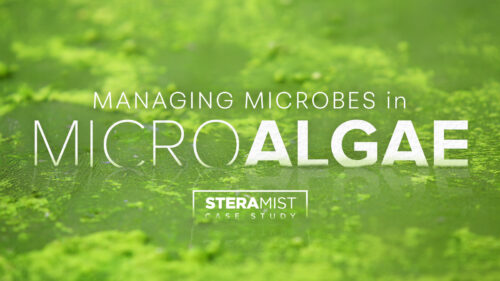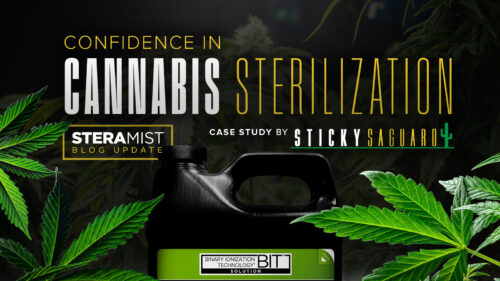Case Study – Lenderking
STERAMIST™ BIT™ & COMFORT CAGE HYGIEIA CASE STUDY
Situation Overview: The US National Library of Medicine National Institutes of Health reports that good science and good animal care go hand in hand. A sick or distressed animal does not produce the reliable results that a healthy and unstressed animal produces. In the case of experimental laboratory mice, understanding the vigor and well-being of the mice enables researchers to optimize their results and the animal’s care1. This includes creating a comfortable habitat as well as keeping unintended pathogens from compromising a project’s credibility. Several infectious agents have been identified over the years as causing adverse effects to an animal’s health and/or a research project’s outcome1. Therefore, producing an environment that is comfortable and free of contagions is essential for both SPF and non-SPF mice colonies. Further, the US National Library of Medicine National Institutes of Health states that many microbial outbreaks are subclinical in mice. This makes it imperative that laboratories have a state-of-the-art disinfection system and protocol to prevent disease because early detection in mice is likely harder to gage. This case study will outline ways to improve the quality of life in laboratory mice and reduce the risk of infectious diseases. Ultimately, this combined approach will help save research funds and limit unwanted scientific variables.
Approach: To create the highest quality of life for laboratory mice, researchers and veterinarians must replicate living conditions that will support thriving colonies. Mice are inquisitive and active, and will generally be observed moving around the cage, grooming, eating, drinking and interacting with cage mates1. This means that colonies are their healthiest when air quality is high and bedding is clean and dry. Lenderking Caging Products, America’s oldest caging company, identified the need for a cage and rack system that would allow researchers to extend cage change intervals. This method reduces stress in mice and saves research funds spent on consumable resources (bedding, food, and detergent), water, energy, and labor. In addition, TOMI Environmental Solutions’ groundbreaking disinfection system, SteraMist™ utilizing Binary Ionizing Technology® (BIT™) offered the ideal disinfection method. This disinfection system kills infectious pathogens on contact without the use of toxic chemicals. Here is a detailed explanation of two innovative systems.
- Lenderking’s Comfort Cage Hygieia: This individually ventilated cage (IVC) and rack system for mice is designed to save research funds and present both research subjects (mice) and technicians with a healthy ammonia-free environment. The patented design introduces HEPA filtered air below a perforated raised floor suspended above the plastic cage bottom. The bedding and enrichment materials sit atop the raised floor which incorporates 7,000 small holes to distribute the airflow through the bedding. This design is known as the FlowThru™ Bedding design. Bringing the airflow into the cage below the bedding level allows Hygieia to maintain a micro-environment with significantly lower ammonia levels using 75% less airflow than other IVCs on the market. Typical IVCs require 60 air changes per hour (ACH) and cage changes every 10-14 days to maintain a healthy environment. Using 15 ACH, Hygieia was able to extend cage change intervals to 33 days on fully loaded cages of 5 adult females or 2 adult females and their litters in a study conducted at the University of Maryland. Mice exhibited no aggressive behavior, were eating and drinking normally and showed no signs of dermatitis or other effects to their coat. Serology panels showed no infection, meaning the HEPA filters associated with Hygieia are working correctly. Histology analysis of the nose, lung and throat tissues from 23 representative animals all fell within normal limits, even on all pup samples born inside Hygieia.
- SteraMist™ BIT™: TOMI™ Environmental Solutions, Inc. is a global bacteria decontamination and infectious disease control company, providing environmental solutions for indoor surface decontamination. Its primer disinfection system, SteraMist™ BIT™, was developed in conjunction with the Defense Advanced Research Projects Agency (DARPA) in response to Amerithrax (anthrax attacks) post 9/11/2001.The patented two-step process activates and ionizes a 7.8% hydrogen peroxide solution creating a fine mist called Activated Ionized Hydrogen Peroxide (AIHP). AIHP contains a high concentration of Reactive Oxygen Species (ROS), consisting mostly of hydroxyl radicals, which damages pathogenic organisms through oxidation of proteins, carbohydrates, and lipids. This leads to cellular disruption and/or dysfunction and allows for disinfection in targeted areas and large spaces. Utilizing the SteraMist™ Surface Unit, Comfort Cage Hygieia was able to be fully disinfected, quickly and effectively.
Impact:
The ease of use of both systems, Comfort Cage Hygieia and SteraMist™ BIT™, makes resetting for the next study a fast, accurate, and easy operation. Unlike many other IVCs on the market, Hygieia requires no disassembly of plenums, ports, ducts, or anything connected to the rack. The horizontal supply and exhaust ducts allows the SteraMist™ AIHP mist to travel the entire length of the duct (seven feet) and visibly exit through the opposing end in under two seconds. In a single cage connected to the center of the rack, biological indicator strips registered a 106 reduction in organisms inside the cage. In order to get autoclave level kills inside a whole row of cages connected to the rack, only one vertical plenum is opened, with the opposing plenum remaining closed. This will allow SteraMist™ to enter all eight cages in one horizontal row.

Conclusion: Now researchers can double cage change intervals meaning mice are handled less, lowering their stress levels and reducing mistakes, which most often happen during cage changes. After a successful 33 day no cage-change study, SteraMist™ BIT™ attained broad spectrum disinfection. In addition to disinfecting animal cages and racks, SteraMist™ BIT™ can safely disinfect all laboratory spaces and equipment.
Testimonial: “We used SteraMist™ BIT™ to disinfect our Comfort Cage Hygieia IVC rack system after a 33 day, no cage change, live animal study. Not only was SteraMist™ BIT™ incredibly easy to use and fast acting, but we got autoclave level kills on every nook and cranny of our system. With no disassembly needed to apply SteraMist™ BIT™ to Hygieia, we were disinfected and ready for the next study in less than 20 minutes. For easy, efficient and effective disinfection, SteraMist™ BIT™ is a great option!” – Liz Kramer, Senior Analyst, Lenderking Caging Products



